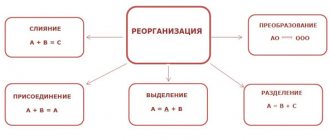When an organization closes, all employees go through a number of unpleasant moments.
Some people quit on their own, many change their job to a similar one or go into another activity, the rest are subject to a general wave of freeing up work space. So what to do with those employees who, at the time of reorganization or bankruptcy, do not have the opportunity to influence and determine the further course of events? Below we will consider the basics of the emergence and ways of resolving the following problem of the company’s activities - the dismissal of a maternity leave during the liquidation of the enterprise. How to resolve such a situation with mutual benefit for both parties? Let's look at the basic rules for dismissing employees on maternity leave or parental leave. We recommend that you carefully read and study the details and nuances of this procedure. In the event of a violation by personnel specialists, any employee, including women on maternity leave, has the right to go to court with demands to restore their rights, make a full payment of all funds, etc.
The Labor Code provides support and assistance to women on maternity leave at the time of liquidation of their permanent place of work. Here you have the opportunity to turn to the guarantees that employees have and are regulated by law on how to properly liquidate an enterprise without causing much harm to employees.
At the initial stage, it is necessary to consider and analyze the definition of the concept of “liquidation of an enterprise”. This is the termination of any areas of the company’s activities, the main purpose of which is exclusion from the general state register. There are two main types of how a company can be liquidated:
- On a voluntary basis - the final decision is made by the employer. It is possible to transfer to another company (subject to written consent).
- On a preliminary basis - here the final word remains with the parent companies. And all responsibility for the subsequent search for a worker for the employee is handled by the employment service.
Legal grounds for dismissal of maternity workers during liquidation
Back in 1917, the government made a decision detailing maternity benefits. There is no clear concept of a decree in the current legislation. But traditionally this concept is associated with two periods of time when an employee is relieved of her duties:
- Childbirth.
- Further care for the baby until he reaches a certain age.
The first type of leave is available directly to the mother. The second type of vacation can be arranged by other relatives if they are involved in raising children.
The law prohibits the dismissal of any employee who is on vacation; the reason does not matter. This is stated in Articles 81 and 261 of the Labor Code of the Russian Federation. The same applies to persons with family responsibilities. But the case of liquidation of a company becomes an exception.
Under such circumstances, the employer will be required to terminate all previously concluded employment agreements.
The procedure for dismissing maternity workers during liquidation
If the company is liquidated, the procedure will look like this:
- Trade union bodies must be notified at least three months before the event occurs. Separate negotiations are carried out to monitor compliance with the interests and rights of each interested party.
- The employment service is notified within the same deadlines. Be sure to send the employee’s personal information, including length of service, position, qualifications, and total salary.
- The maternity leaver herself is introduced to the order, also at least two months before the event.
- If the employee cannot personally familiarize herself with the document, they draw up an act related to absence and loss of ability to work. Notice of dismissal is subject to the same rules.
- Information is also included in the work book.
- On the last day, all necessary calculations are carried out. It is mandatory to issue a certificate of income and all necessary documentation. This simplifies further interaction between citizens and regulatory authorities.
Article 81 of the Labor Code is the main document that regulates the procedure and order.
Maternity leavers have the right to terminate agreements on their own initiative. To do this, you don’t have to wait until the company is liquidated. Then you can request another compensation calculation - wages in the minimum amount, from the moment of dismissal until the final liquidation of the enterprise.
How to fire a maternity leaver due to the liquidation of an enterprise
The dismissal of a maternity worker during the liquidation of an enterprise is an inevitable procedure, despite the fact that the rights of expectant mothers are vigilantly protected by the state. Pregnant women are immune in labor disputes. Neither the probationary period nor numerous disciplinary violations and absenteeism can provide a legal basis for their dismissal. And even with the only permitted way to reduce them, such as closing an enterprise, you will have to follow a certain procedure in order not to fall victim to litigation and fines.
Liquidation of a company is the termination of its existence by making an appropriate entry in the Unified State Register of Legal Entities (USRLE). All rights and obligations of the company are extinguished and are not transferred to anyone. That is, managers and owners become completely clear before creditors, tax authorities and the Department of Internal Affairs.
This process is complex and time-consuming; it is regulated by Articles 61 – 64 of the Civil Code of the Russian Federation. Liquidation can be voluntary or forced. The most correct way to release the responsible persons (chief accountant and general director) from subsidiary liability is voluntary liquidation, it begins with the adoption of a decision by the shareholders, then a certain sequence of actions is required.
Why does the owner decide to close the company:
- creditor claims;
- requirement of government agencies;
- redistribution of business capital;
- unprofitability of existence;
- violations of accounting or tax reporting, when it is easier to eliminate the company than to pay large fines during the next audit.
Whatever the reason for closing the company, there comes a time when the manager understands that the legal entity must be officially closed.
A liquidation commission is being assembled, which will be obliged to inform the tax authorities about the completion of the liquidation, but before that, make a publication in the media two months in advance. The minimum period determined by law is 3 months, the maximum period is not established. In reality, the process of voluntary liquidation takes from 5 months to a year.
The procedure for liquidating an enterprise:
- A decision is made, a commission is appointed, and the registration authority is notified. After submitting the message, the tax authority makes an entry about the beginning of liquidation in the Unified State Register of Legal Entities and issues a certificate to this effect.
- The Pension Fund and Social Insurance Fund are also notified.
- In the official media - "Bulletin of Economic Justice" and "Bulletin of State Registration" - a message about liquidation is printed.
- Employees of the organization, creditors and the employment service are notified no later than two months in advance.
- Reconciliation with tax authorities is carried out through an on-site audit. As a result, residual penalties and fines are usually assessed.
- An interim liquidation balance sheet is formed.
- Settlements with creditors are carried out, as well as inventory and distribution of the remaining property of the company.
- A liquidation balance sheet is formed and state registration of liquidation is carried out.
After liquidation, creditors and authorized bodies do not have the right to demand debts if they did not manage to declare them within the period established by law. This applies to labor disputes and penalties.
So, as soon as you find out that the company you work for is closing, it is important to ensure that you take the right steps in relation to your dismissal before it is too late.
Maternity leave is usually understood to mean only maternity leave (Maternity leave), although sometimes it also includes leave to care for a child up to one and a half years and from one and a half to three years (Article 255 of the Labor Code).
When the employing organization is liquidated, absolutely the entire staff is dismissed. Even those who are on sick leave, on vacation, on maternity leave, as well as pregnant women (Article 81, 261 of the Labor Code).
How to fire a maternity worker during liquidation of an enterprise? The algorithm for your separation from the company will be common to all employees.
You:
- Receive an individual notification of your upcoming dismissal against your signature. The deadline for receiving it is no later than two months before the date of termination of the contract. Keep your personal copy of the notice (Article 180 of the Labor Code). If you refuse to sign the introductory document, the liquidation commission will draw up a corresponding act. If you are not at your workplace, the notification will arrive by mail, and the two-month period will begin to count from the moment you sign on the delivery receipt.
- Receive the payments due to you: salary for hours worked, compensation for unused vacation, severance pay.
- On the last day, receive a work book and duly certified copies of documents related to work (Article 84.1, 127TK).
If the employer has not violated the deadlines for notification and payments, and has properly executed the notice, order, and labor report, then he will subsequently avoid disputes and fines related to the dismissal of the maternity leaver.
The benefit you will receive upon dismissal (Article 178 of the Labor Code):
- severance pay in the amount of one month's salary;
- average monthly earnings for the entire period of work, paid for two months, taking into account severance pay;
- with the approval of the employment service, a pregnant woman can also receive payment for the third month if she has not found a job within 2 weeks from the date of dismissal.
The amount of benefits is calculated as the average salary for the period from dismissal to liquidation of the organization.
If you are about to be dismissed as a maternity leaver due to the liquidation of an enterprise, and you are asked to write a statement of your own free will, do not do it. This is your right, not your responsibility. Sometimes a company, under the pretext of liquidation, can go through restructuring or a change of ownership. In this case, the new owner must receive the company with all maternity leave. And if you did not agree to leave voluntarily, then you will continue to be registered with the new company.
https://youtu.be/6erDqtdGJRY
According to the law, a woman can receive maternity payments and child care benefits from the regional branch of the social insurance fund. Until recently, it was necessary to provide written confirmation that the company had gone bankrupt. This requirement greatly complicated the ability to receive the money required by law - women had to sue former employers privately due to the fact that the bankruptcy process was delayed for many years.
The Ministry of Labor resolved this injustice by introducing amendments to the legislation. Now payments are made immediately after contacting the social insurance fund office, and all issues related to the preparation of certificates are taken care of by the fund’s employees. You just need to provide a standard set of documents, find out which one exactly on the website fss.ru.
Legal consultations:
- I am on maternity leave, I was fired due to the liquidation of the organization. Who should pay me a monthly child care allowance and how much? In accordance with the law, for those who are not subject to compulsory social insurance, but care for the baby, the allowance is issued to the social protection authorities in your area. Based on Article 15 of the Federal Law of May 19, 1995 No. 81-FZ “On state benefits for citizens with children”, in the event of liquidation of an organization, a monthly child care allowance is paid in the amount of 40% of average earnings from the day following the day of dismissal from work until the day the child turns one and a half years old.
- Will I be paid a labor and employment benefit if I quit my job two months before maternity leave and am registered with the Employment Center? This benefit is paid only to working women. Unemployed women registered with the employment service are not entitled to maternity benefits.
- I am on maternity leave to care for a child up to 1.5 years old. My company is being dissolved and I am being asked to write a letter of resignation of my own free will. What to do? You are not required to resign of your own free will. You can be fired only upon liquidation of the enterprise, taking into account all the privileges of the Labor Code: you have the right to receive benefits for six months after dismissal. If your employer violates your rights, file a complaint with the prosecutor's office, the State Labor Inspectorate and the Investigative Committee at your place of residence. Attach a copy of the employment contract to your application.
- What to do if, allegedly due to a lack of money, the employer does not pay the required payments at the birth of a child, and the territorial social insurance authority refuses to do so, citing the lack of grounds for payment? The territorial social insurance body has the right to pay benefits instead of the employer if the company is subject to procedures applied in a bankruptcy case (Part 4 of Article 13 255-FZ) or if it does not have enough funds in its accounts with credit institutions. If this is not your case, you should apply to the court to recover the amount of the due payment, and then submit a writ of execution to the Bailiff Service.
Administrative liability has been established for employers for incomplete payment of benefits (Part 6, Article 5.27 of the Administrative Code). Such a statement should be submitted to the State Labor Inspectorate.
For partial non-payment of benefits by the employer for more than 3 months, complete non-payment of benefits for more than two months, committed out of mercenary or other personal interest, as well as if these acts entailed grave consequences, criminal liability is established (Article 145.1 of the Criminal Code).
An application for criminal prosecution may be submitted to the authorities of the Investigative Committee of Russia. Mothers dismissed during maternity leave due to the cessation of the organization's activities, in addition to the application, submit:
- an extract from the work book about the last place of work, certified in the prescribed manner;
- a copy of the order granting parental leave until the child reaches the age of three;
- a certificate of the amount of the previously paid monthly child care allowance;
- a certificate from the state employment service about non-payment of unemployment benefits.
Other documents are provided in case of leave under the BiR.
Women who were dismissed due to the cessation of the enterprise's activities should provide the following documents to the social security authority to receive benefits for employment and economics:
- application for the assignment of benefits for B&R;
- certificate of incapacity for work;
- an extract from the work book about the last place of work, certified in the prescribed manner;
- a certificate from the employment service authorities recognizing them as unemployed;
- a certificate from the social protection authority stating that the benefit was not assigned.
Payment of benefits is carried out by social protection authorities through federal postal organizations or credit organizations indicated by the recipients of benefits no later than the 26th day of the month following the month of receipt (registration) of the application with the above documents.
Amount of benefits from February 1, 2020:
- The amount of maternity benefits for women dismissed due to the liquidation of the organization was 300 rubles. From February 1, 2018, the benefit is set at 628 rubles 47 kopecks.
- The benefit for women who registered in the early stages of pregnancy increased to 628.47 rubles. (RUB 613.14 x 1.025). This is how much you need to pay if maternity leave began on February 1, 2020 or later.
- The benefit for the birth of a child has been increased to 16,759.09 rubles (16,350.33 rubles x 1.025). This amount of benefit must be paid for children born on February 1 or later.
- Allowance for child care up to 1.5 years. Whether indexation affects the minimum amount of benefits for caring for the first child depends on when the leave began: before the New Year’s increase in the minimum wage or after it. This follows from Part 1 of Art. 11.2 and part 1.1 of Art. 14 of Law No. 255-FZ. There is no need to increase benefits paid in the minimum amount if parental leave began no earlier than January 1, 2018. In this case, the amount of the benefit remains the same – 3795.6 rubles. (40% minimum wage). The minimum amount of benefits for caring for a second child and subsequent children is easier: from February 1, it is indexed for everyone. New size – 6284.65 rub.
There is no need to receive any applications for increased child benefits from employees.
What benefits will a maternity leave person receive?
Pregnant women in the event of company liquidation can count on the following compensation:
- Child care allowance, if warranted.
- Temporary loss of ability to perform labor functions.
- All accruals reflected in the company’s internal regulations.
- Replacement with the cash equivalent of each day of vacation that remains unused.
- Full payment of wages for the period when the citizen worked at the enterprise.
The employer assigns payments if sick leave is sent before dismissal. On the day of dismissal, transfers related to child care upon foundation must cease. Transfers are made for all previous days before the date of dismissal. After the liquidation of the enterprise, representatives of the Social Insurance Fund are subsequently responsible for resolving this issue.
Even if at the time of liquidation the employee was on vacation, her rights are no different from other subordinates going through the same thing.
What to do if you receive a notice of liquidation?
Dismissal at the initiative of the employer forces any employee to start looking for work. One of the reasons for such an initiative is the liquidation of the enterprise and pregnancy does not make the employment process easier for employees. If girls in the early stages are still able to solve this problem on their own, then women approaching maternity leave or already on it are unlikely to be of interest to employers.
After receiving a notice of dismissal due to the liquidation of a pregnant woman's enterprise in the early stages, it makes sense to immediately start looking for work and, if there is a suitable offer, resign by agreement with the employer before the expiration of the notice period, so as not to have time to scare the potential employer with your interesting position.
If you cannot find a job, you will have to contact the employment center.
Paragraph 2 of Article 180 of the Labor Code establishes that a pregnant employee must be notified of the upcoming layoff at least 2 months before the actual termination of the employment relationship.
The notice is drawn up in two copies, one of which is given to the employee, and the second remains at the enterprise. The parties may agree on early termination of the employment relationship while maintaining the due payments and compensation.
Features of the preparation of personnel documentation
It is necessary to adhere to the standard procedure associated with the dismissal of workers. A mandatory requirement is to draw up an order containing the following information:
- The reason why employment agreements are terminated.
- Indication of the position.
- The name of the document, a statement of its essence.
- The exact reason for dismissal.
- Business name.
- Document Number.
Closing an enterprise allows you to dismiss women on maternity leave using general grounds.
Instant notification of what is happening is often impossible due to the fact that the woman is not at her workplace. The employer must in any case involve employees in personally familiarizing themselves with the papers.
When the day of dismissal approaches, the employee must receive the following papers:
- A copy of the sick leave certificate.
- A copy of the application for benefits for caring for a child up to one and a half years old.
- Order of dismissal.
- Help 2-NDFL.
- Help regarding wages.
Women's rights
Dear readers! The article talks about typical ways to resolve legal issues, but each case is individual. If you want to find out how to solve your particular problem , contact a consultant:
+7 (499) 110-56-12 (Moscow)
+7 (812) 317-50-97 (Saint Petersburg)
8 (800) 222-69-48 (Regions)
APPLICATIONS AND CALLS ARE ACCEPTED 24/7 and 7 days a week.
It's fast and FREE !
The current legislation contains a system of norms that ensure the protection of the rights and interests of women. All participants in labor relations, including the employer, must be guided by established standards.
Ignoring the norms is a violation of the Labor Code, which entails liability on the part of the violator.
Thus, among the norms protecting the interests of pregnant women, it is necessary to highlight the following:
- Article 41 of the Labor Code of the Russian Federation regulates the rights of women and children in relation to labor relations.
- Article 253 of the Labor Code of the Russian Federation includes norms that limit the work activity of women during pregnancy and caring for a child up to 1.5 years old.
- Articles 255 -258 of the Labor Code of the Russian Federation determine the procedure for women on maternity leave.
- Articles 259 - 261 of the Labor Code of the Russian Federation contain guarantees for this category of employees regarding exemption from working overtime, on weekends and holidays.
Making an entry in the work book
It is necessary to go through a number of important procedures in order for the issue to be resolved in compliance with current legislation:
- Issuance of an order, affixing a personal signature. Be sure to write the date and real reason for dismissal. The same applies to compensation payments to an employee. This information is required.
- Filling out a personal file with information related to dismissal. An entry in the employee’s work book is also made under appropriate conditions. The main thing is to correctly record the reason for dismissal and indicate the order number. Then the registration will not violate the requirements of current legislation.
Registration of dismissal
Registration of dismissal of employees of a branch located in an area different from the location of the head office is carried out in the same manner as during the liquidation of a company.
Thus, the branch manager will need:
- Notify those being laid off in advance of the impending termination of employment contracts.
- Notify the trade union body (if there is one) and the employment service about the upcoming liquidation.
- Issue orders for the dismissal of employees.
- Make appropriate entries in the work books and personal cards of dismissed employees and make final payments to them.
For those employees who are on maternity leave at the time of liquidation of the branch, the rules for dismissal remain the same as for other categories of employees.
Issuance of an order
The order is issued based on the decision of the management of the parent company; it is usually based on form T-8, approved. Resolution of the State Statistics Committee “On approval of unified forms...” dated 01/05/2004 No. 1 (hereinafter referred to as Resolution No. 1). The contents of the order are brought to the attention of all employees against signature. If for some reason this is impossible to do, for example, the employee is not at work (is on maternity leave) or he refuses to sign, then a corresponding entry is made in the order (Part 2 of Article 84.1 of the Labor Code).
Drawing up a note-calculation
Upon dismissal due to the liquidation of a branch, a settlement note is drawn up, which is best drawn up on the basis of a unified form. T-61, approved. Resolution No. 1. This form is used to calculate and record all due payments to a dismissed employee who is on maternity leave. When calculating payments, compensation for unused annual leave and deduction for leave that was used in advance are taken into account.
Filling out a work book
A fully completed work book must be issued on the last day of work before dismissal (Part 4 of Article 84.1 of the Labor Code). Due to the fact that an employee on maternity leave is not present at the workplace on the last day of work, the work report, upon his request, is sent by mail or transferred for archival storage.
A record of dismissal is made in the work book with reference to clause 1, part 1, art. 81 TK. The entry made is certified by the employee responsible for maintaining such documents and the seal of the parent company (if there is one in the organization). In addition, according to clause 35 of the rules for maintaining and storing work books, approved. Government Decree “On Work Books” dated April 16, 2003 No. 225 (hereinafter referred to as the Rules), the signature of the dismissed employee must be affixed. Since a person on maternity leave does not go to work until the end of the corresponding leave, the work report, in accordance with clause 36 of the Rules, is, with his consent, sent to his home by mail.
Filling out a personal card
Personal card, which is usually issued by f. T-2, approved. Resolution No. 1 contains all personal information about the employee. Upon dismissal due to the liquidation of a branch, a corresponding entry is made in it. When issuing a work book to an employee, a corresponding entry is also made in the personal card, with which the dismissed employee must be familiarized with his signature (clause 41 of the Rules).
About other cases of dismissal of maternity workers
Upon dismissal, women on maternity leave, in addition to the usual payments, are entitled to additional compensation:
- Child benefit is one-time.
- Child benefit paid every month.
If all documents are submitted to the employer, the social security authorities transfer all the necessary funds for maintenance.
If by the day of dismissal there is no exact calculation of monthly allowance, the amount of payments reaches 40% of average earnings. The reporting period for this issue is 12 months preceding the time of application for help.
Once again, benefits will not be calculated if at the time of dismissal the woman is already on maternity leave. They only make payments depending on previous agreements with the employer.
Doubts often arise about whether severance pay is due to those who are on leave to care for children under 3 years of age. Don't trust HR staff. They often say that payments are not due due to the fact that the previous 12 months were not paid in any way.
The period of maternity leave is simply excluded from the calculation. The calculation takes into account the period before the baby appeared and required additional care.
Features for sick leave
The average salary for the entire vacation period is the standard amount of compensation when sick leave is provided to the employer.
The obligation to pay benefits is removed if sick leave is filed in the month when the dismissal has already taken place.
Women retain their right to benefits in the following situations:
- The contract was terminated due to the need to care for a sick family member with a first group disability.
- The disease made further work and living in these parts impossible.
- Translation by husband.
Payments and compensations
When an enterprise is liquidated, management faces several global tasks, and one of the most important is compensation for the damage caused to employees due to loss of work. Compensation has clearly established limits and is enshrined in legislation.
The employer is obliged to pay each dismissed person:
- His previously unpaid wages.
- Compensation for missed vacation.
- Liquidation benefit.
Salary and vacation pay are standard payments accrued upon dismissal. But the liquidation allowance is a special type of payment that is aimed at supporting those laid off while they look for another job. Payments in connection with the liquidation of an enterprise are equal to two average monthly salaries of a specific employee.
Employees who are on maternity leave at the time of closure of the organization also receive all the amounts listed and a two-month compensation allowance. To calculate it, the accounting department calculates the employee’s average monthly income, which is multiplied by two. This benefit is paid to support a person while looking for work. And although women on maternity leave, for obvious reasons, cannot go to work in their position, they are also entitled to this payment in the same amount as other employees.
There are cases when benefits may not be accrued, for example, if the court determines the bankruptcy of the organization. Then payments are made only to the extent that management can handle or employees quit without it at all.
Bankruptcy does not cancel the obligation to pay wages and compensate for unpaid vacation days.
What else should you know when dismissing a maternity leaver?
In further payments after dismissal, a role is also played by whether the woman was able to officially register with one of the employment centers after receiving status. If there is a reason to pay benefits, and no more than a year has passed between the dismissal and the current moment, you can safely contact the employer.
The Social Security Service is responsible for benefits if maternity leave has already been received at the time of dismissal. But payments in this case will be minimal.
To extend payments, a woman will need the following documents:
- A copy of the sick leave certificate.
- Order of dismissal.
- Application for leave.
- Certificate of income for the last 2 months.
- Certificate of accrued benefits.
Organization liquidation process
As a result of liquidation, the company finally ceases its activities and is excluded from the Unified State Register of Legal Entities. There are two types of liquidation:
- Voluntary - when the owner himself decides to stop operating. In this case, employees can transfer to another organization while an official decision has not yet been made.
- Forced - the process is initiated by a higher company or founders. Dismissed employees must subsequently be employed by the employment service.
The entire liquidation process from the moment the decision is made to the final closure of the company can take 4-8 months. This time is needed to complete all mandatory procedures. There are certain stages of liquidation of a company:
- A decision is initiated to begin this procedure, and a special commission is created.
- A notification is sent to the district tax authority. This must be done within three days of the start of the process.
- Information about the termination of activities is published in specialized printed publications: “Bulletin of State Registration” or “Bulletin of the Supreme Arbitration Court of the Russian Federation”.
- Written notifications are sent to employment services, creditors of the organization and employees of the company.
- An audit is being carried out by the field tax service. It lasts approximately three months.
- Debts are collected from the company's debtors.
- A liquidation balance sheet is drawn up.
- An inventory of property is being carried out.
- Debts to creditors are reimbursed.
Decision to terminate the activity of the entity
Liquidation of an enterprise is a fairly time-consuming process. The procedure consists of several stages. Article 81 of the Labor Code of the Russian Federation regulates interaction with employees if the reason is the bankruptcy of a legal entity.
Under such circumstances, women on maternity leave have continuous service until the legal entity is deleted from the register.
Payments to employees consist of wages and severance pay for the previous 2 months. The question of self-dismissal most often arises under two circumstances:
- The procedure took a long time.
- The employer is insolvent.
You can agree to this proposal, then all calculations are carried out in an expedited manner.
If liquidation occurs in the standard manner, even dismissal in case of absence from work is provided. This also applies to those who are on vacation for health reasons, due to the need to care for children and relatives.
But the employer is still obliged to tell about the dismissal. The notification must be received within the period established by law.
Arbitrage practice
Dismissal of maternity workers during liquidation is the only situation when employees’ claims are practically not satisfied when going to court. Employers have the right to act on personal initiative.
Employers retain the right to dismiss, even if they were not warned about the pregnancy of their employees. At the same time, any actions are carried out as if they do not violate current laws.
A claim for violation of legal rights will be satisfied only if the pregnant woman did not receive notice of the upcoming event within the time limits specified by law. But even in such situations, more money is spent than real results are achieved.
It is better when there is agreement to sign an agreement on terms that satisfy both parties. Example - compensation can be reduced by half, but at the same time get rid of the need to stand in a general queue.
As a general rule, a company may show signs of bankruptcy. This process can take 18 months or more, even if the employer meets all the requirements. The actions of temporary managers and other features of the procedure often lead to the fact that the company is unable to transfer the minimum amounts.
Because of this, there is also a high probability that the woman will not receive the money due. Sometimes it is better to immediately reduce the amount, but get it as quickly as possible. So as not to face negative consequences later.











